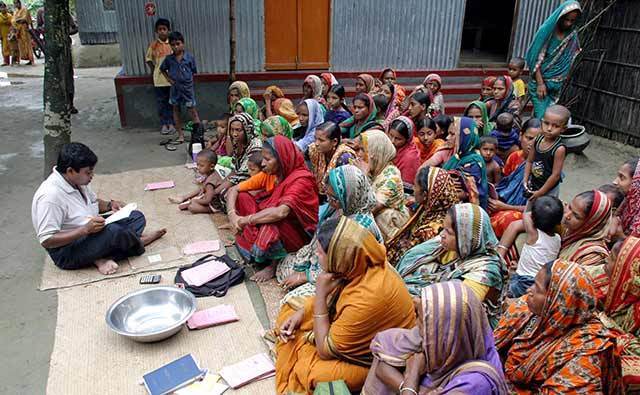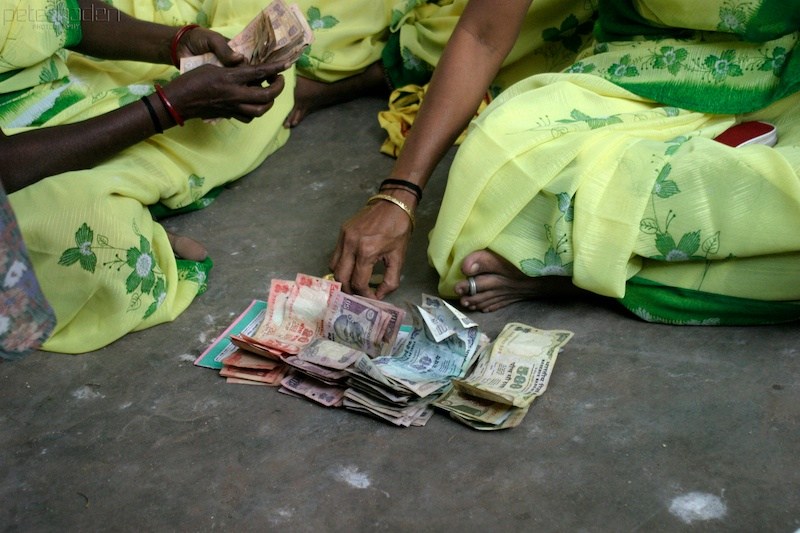
Microfinance institutions lend at between 20% and 26% and are able to get all their money back with negligible non-performing assets. Credit: Reuters
A fundamental change is taking place in Indian banking which has the potential to become as dramatic as bank nationalisation. The process is understood, but its likely impact is not. Hence the issue is missing from headlines.
Chandra Shekhar Ghosh, founder and chief of Bandhan Bank, the only microfinance institution to become a universal bank, hits the nail on the head when he says, “By 2030 microfinance institutions (MFIs), small finance banks and banks like Bandhan (coming up from the bottom) will dominate rural banking and they will remain absolutely viable.”
Ghosh is not the only financial sector leader to think along these lines, but he is particularly qualified to say what he has because of the way in which Bandhan Bank has fared in the first two years of its operations as a universal bank. So, first, a look at what Bandhan Bank has achieved and then outlining how this feeds into a bigger picture.
In public displays, Bandhan Bank is celebrating the completion of its second year by claiming that it is the fastest growing bank in India. But a far more important achievement lies in what it has done in one half of its business – getting deposits. When it started off in August 2015, it took over the entire microfinance loan portfolio of its earlier avatar. So it had a readymade loan book to begin with.
But on the liabilities side of its business, it began with zero deposits. As an MFI, it was not allowed by the banking regulator, Reserve Bank of India, to accept deposits (your savings and mine) and had to lend from loans taken from banks. Now it could accept deposits as a bank. In two years, by the end of the first quarter of the current financial year (June 30, 2017), it has been able to fund its entire lending programme totalling Rs 21,400 crore from its own deposits, which totalled Rs 22,400 crore. Simultaneously, it has been meeting all the reserve requirements of the RBI and maintaining a healthy capital adequacy ratio of 26%.
According to Ghosh, when Bandhan Bank started off it was able to cajole its consultants to set a target of Rs 3,500 crore of deposits for the first year (they were inclined to be more conservative). In seven months it achieved a deposit base of Rs 12,000 crore. The strategy that enabled this had two elements – reaching people and providing service. People want a service at a branch which does not make them wait for long. “The physical touch, customer relationship at the branch, will remain important. Over the internet you can find out the interest rate, not the type of behaviour you will get. It is the branch infrastructure that reaches the bank to the people. Rural people find a bank branch to be a bit forbidding. There is a need to make a bank branch simple, not hi-fi.”
The opportunity that Bandhan Bank has exploited is the continued “weak banking structure” in rural areas. Existing banks have been hamstrung by the inability to get qualified staff to serve in rural branches. Those that agree to insist on commuting from nearby urban areas. Plus, existing banks have been unable to reconcile themselves to the reality that rural branches take longer to break even.
While on the deposit side the bank has been able to deliver in a new area, on the lending side there has been considerable continuity. In granting loans, the bank substantially retains its microfinance character. This business continues and is growing, with microfinance type of loans accounting for 90% of total lending. It lends to individuals and the MSME (micro, small and medium enterprises) sector, with average loan size to the latter being around Rs 5 lakh, and no lending to corporates at all.
As half a startup, Bandhan Bank is growing fast, but how profitable are its operations? A comparison with HDFC Bank, the performance leader among Indian banks, is instructive, although the two are not strictly comparable. In the 2017 financial year, Bandhan Bank secured a return on assets of 4.5%, HDFC Bank 1.9%. On the bad debts front, Bandhan Bank recorded gross non-performing assets (to total assets) of 0.82%, HDFC Bank 1.05%. On net interest margin (difference between overall lending rate and borrowing rate) which gives a measure of profitability of operations, Bandhan Bank clocked 10.75% and HDFC Bank 4.3%.
The huge difference in the last measure is explained by legacy factors. From borrowing from banks at around 10%, Bandhan Bank is now able to access deposits at a rate which is several percentage points lower. Also, microfinance loans are given at upwards of 20%, whereas commercial banks lend at almost half that rate.

Microfinance, which lends without securities to women at the bottom of the pyramid, is intrinsically strong. Credit: Peter Haden/Flickr CC BY 2.0
Demonetisation risks
Can we use the financial performance of Bandhan to reflect the strength of the entire microfinance sector? Here we come up against the tsunami that demonetisation has unleashed on the microfinance sector whose borrowers deal mostly in cash.
The portfolio at risk or PAR (as measured by loans which are overdue for 30 days) of the microfinance institutions registered as non-banking financial companies (NBFCs) with the RBI or NBFC-MFIs (these are the big MFIs) sector rose from a mere 0.4% in FY 2016 to 14.1% in FY 2017 as a result of demonetisation, according to Micrometer, brought out by Microfinance Institutions Network, the body which represents NBFC-MFIs. But interestingly, the PAR falls when we look at longer periods. It is 8.2% for loans overdue for 90 days and down to a negligible 0.22% for loans overdue for 180 days. Hence borrowers did have initial difficulty in repaying but recovered over time.
One reason why the microfinance sector as a whole has not done as well as Bandhan Bank is that as a bank, it could accept old currency notes immediately after demonetisation which MFIs could not. Hence Bandhan Bank was able to achieve huge deposit growth, making demonetisation a blessing in disguise. But MFIs, which could not accept old currency notes, suffered through delayed repayments which involved writing off of overdue interest when the principal was cleared and the overall cash crunch putting a damper on fresh disbursement, affecting the bottomline twice over.
But the inherent robustness of the MFI sector becomes clear when we see that its gross loan portfolio rose by 25% in FY 2017, compared to 201.8% (doubling) achieved in the previous year, that is financial year 2016.
To come back to where we began, microfinance, which lends without securities to women at the bottom of the pyramid, is intrinsically strong. What the best among them can do is indicated by what Bandhan Bank has been able to do after it could accept low-cost deposits instead of taking high-cost loans from banks. And the good news is that eight leading MFIs have been given the licence to operate as small finance banks (these are able to accept deposits) and several of them have converted.
The final bottomline is that microfinance institutions lend at between 20% and 26% and are able to get all their money back with negligible non-performing assets, compared to nationalised banks which suffer from the poor repayment of small loans. As small finance banks, even if they gradually bring down their lending rates (Bandhan Bank has done so) they will still have lots of margin room to play with, going by the net interest margin of Bandhan Bank.
Banks were nationalised to make banking accessible to all. Public sector banks achieved this task in part and there remained a large unfinished task in terms of completing the process of financial inclusion. Today’s microfinance sector (comprising different elements) will finish this unfinished task and thereby become a dominant player in rural India’s financial sector. This is what Ghosh is quoted as saying right at the beginning of this piece.
Subir Roy is a senior journalist and the author of Made in India: A study of emerging competitiveness (Tata Mcgraw Hill, 2005) and the forthcoming Ujjivan: The microfinance frontrunner (OUP).
[“Source-thewire”]
